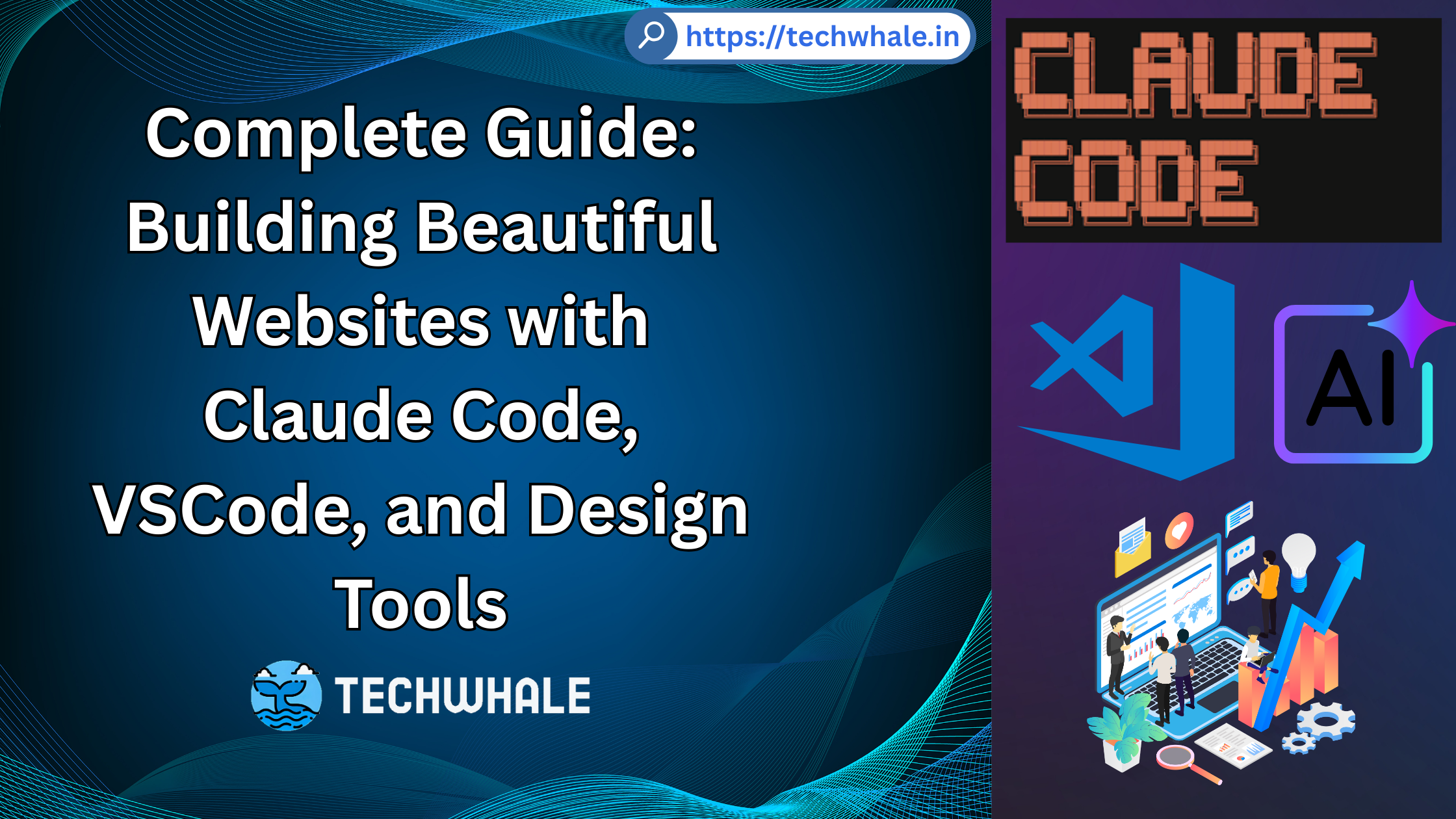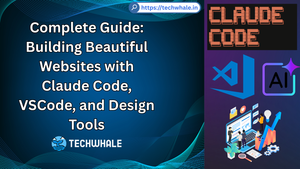
Complete Guide: Building Beautiful Websites with Claude Code, VSCode, and Design Tools
Table of Contents
- Introduction
- Prerequisites & Setup
- Method 1: SuperDesign - AI Design Agent
- Method 2: ShadCN UI Components
- Method 3: Website Cloning with FireCrawl
- Bonus: Figma to Code Conversion
- Best Practices & Tips
- Troubleshooting
Introduction
This guide demonstrates three powerful methods to build stunning websites using Claude Code with VSCode. These approaches leverage AI design agents, component libraries, and web scraping to create professional, responsive interfaces with minimal effort.
🧠 The key insight is that generic prompts like “build a beautiful website” produce generic results. Instead, we’ll use specialized tools and iterative workflows to achieve professional-grade designs.
Prerequisites & Setup
System Requirements
- Operating System: macOS 10.15+, Windows 10+, or Ubuntu 20.04+
- Hardware: 4GB+ RAM (16GB recommended)
- Software: Node.js 18+ and VSCode
- Network: Internet connection for authentication
Step 1: Install Claude Code
Option A: NPM Installation (Recommended)
npm install -g @anthropic-ai/claude-code
Option B: Native Installation
# macOS/Linux/WSL
curl -fsSL https://claude.ai/install.sh | bash
# Windows PowerShell
irm https://claude.ai/install.ps1 | iex
Step 2: Authentication
Navigate to your project directory and start Claude Code:
cd your-project-directory
claude
Follow the OAuth process to connect your Anthropic account or Claude subscription.
Step 3: Verify Installation
claude doctor
Method 1: SuperDesign - AI Design Agent
SuperDesign is an open-source design agent that works as a VSCode extension, optimized for creating frontend components and UI mockups.
Installation
Install SuperDesign Extension
- Open VSCode Extensions marketplace (
Cmd/Ctrl + Shift + X) - Search for “SuperDesign”
- Click Install
- Open VSCode Extensions marketplace (
Initialize SuperDesign
# Open command palette Cmd/Ctrl + Shift + P # Type and select SuperDesign: InitializeOpen Design Canvas
# Command palette Cmd/Ctrl + Shift + P # Select SuperDesign: Open Canvas
Workflow Process
Phase 1: Layout Design
Start Claude Code in your project directory and begin with layout iterations:
claude
Example Prompt:
Create 5 different layout iterations for an Uber-style ride-sharing app home screen. Focus on the main structure and component placement.
SuperDesign will generate ASCII layouts in the terminal, allowing you to quickly evaluate different structures before writing code.
Phase 2: Theme Development
Select your preferred layout and move to styling:
Example Prompt:
I like layout #2. Now create 5 different theme variations focusing on:
- Color palette application
- Typography choices
- Visual hierarchy
- Design language consistency
Phase 3: Color Palette Integration
Use Coolors.co to generate color palettes:
- Visit coolors.co
- Press spacebar to generate palettes
- Copy the CSS values
- Provide to Claude Code:
Apply this color palette to the design:
--primary: #FF6B6B;
--secondary: #4ECDC4;
--accent: #45B7D1;
--neutral: #96CEB4;
--background: #FFEAA7;
Phase 4: Animation & Interactivity
Add micro-interactions and animations:
Add subtle animations to this design:
- Hover effects for buttons
- Loading states
- Smooth transitions
- Interactive feedback for user actions
Advanced Animation Resources
Visit Animatopy for curated animation effects:
- Browse animation collections
- Copy HTML/CSS code
- Integrate into your design through Claude Code
SuperDesign Canvas Features
- Real-time Preview: See changes instantly
- Device Testing: Switch between desktop, tablet, mobile views
- Interactive Elements: Click buttons, type in inputs, test functionality
- Export Options: Copy designs or generate code for other frameworks
Method 2: ShadCN UI Components
Build with professionally designed, accessible components using the ShadCN MCP server.
Setup ShadCN MCP Server
Installation Command:
claude mcp add-json "shadcn-ui-server" '{"command":"npx","args":["-y","shadcn-ui-mcp-server"]}'
Create Workflow Commands
Create a custom slash command for consistent ShadCN workflows. In your project, create:
File: commands/shadcn.md
# ShadCN Development Workflow
## Planning Phase
1. Always use the ShadCN MCP server for component context
2. Plan the entire application structure before implementation
3. List all required components and their relationships
4. Create an implementation plan in implementation.md
## Implementation Phase
1. Reference the implementation plan
2. Use ShadCN MCP server for all component implementations
3. Ensure proper component structure and styling
4. Implement responsive design patterns
5. Add proper TypeScript types
Usage Workflow
Step 1: Planning
/shadcn Plan an e-commerce dashboard using ShadCN components. Create a detailed implementation plan in implementation.md including:
- Component hierarchy
- Required ShadCN components
- Layout structure
- Responsive considerations
Step 2: Implementation
/shadcn Implement the dashboard based on the implementation plan in implementation.md. Use the ShadCN MCP server for accurate component usage.
Theme Customization with TweakCN
- Visit TweakCN.com
- Choose or customize a theme
- Copy the CSS variables
- Apply to your project:
Apply this TweakCN theme to my ShadCN components:
:root {
--background: 0 0% 100%;
--foreground: 222.2 84% 4.9%;
--card: 0 0% 100%;
--card-foreground: 222.2 84% 4.9%;
/* ... rest of theme variables */
}
Method 3: Website Cloning with FireCrawl
Clone existing websites and adapt them with your content using the FireCrawl MCP server.
Setup FireCrawl MCP
Installation:
claude mcp add-json "firecrawl" '{"command":"mcp-server-firecrawl","env":{"FIRECRAWL_API_KEY":"your-api-key"}}'
Get your API key from Firecrawl.dev
Cloning Workflow
Basic Website Clone
Create a 1:1 clone of https://example-website.com including:
- Layout structure
- Component hierarchy
- Styling patterns
- Interactive elements
Enhanced Clone with Screenshots
For better results, include screenshots in your prompt:
Clone this website: https://example-website.com
[Include screenshot of the target website]
Focus on:
- Exact visual hierarchy
- Color scheme accuracy
- Typography matching
- Responsive behavior
Customization After Cloning
Adapt the cloned design with my brand:
- Replace content with [your content]
- Update color scheme to [your colors]
- Modify typography to [your fonts]
- Add/remove sections as needed
Bonus: Figma to Code Conversion
Convert Figma designs directly to code using the Figma MCP server.
Setup Methods
Option A: Composio Figma MCP
# Generate command at mcp.composio.dev
npx @composio/mcp@latest setup "https://mcp.composio.dev/partner/composio/figma/mcp?customerId=YOUR_ID" "figma-server-name" --client
Option B: Native Figma MCP (Requires Figma Desktop)
claude mcp add --transport sse figma-dev-mode-mcp-server http://127.0.0.1:3845/sse
Usage Patterns
Selection-Based Conversion
- Select a frame/component in Figma
- In Claude Code:
Convert my current Figma selection to React components with Tailwind CSS
Link-Based Conversion
Convert this Figma design to code: [figma-share-link]
Requirements:
- Use React/Next.js
- Implement responsive design
- Match colors and typography exactly
- Include hover states and interactions
Best Practices & Tips
Iterative Development Approach
🧠 The power of Claude Code lies in continuous iteration. Unlike human developers, AI agents never tire of refinement, making them ideal for polishing designs through multiple cycles.
- Start with HTML files during initial iterations (easier to modify than full frameworks)
- Use multiple iterations (5+ variations) for each design phase
- Break down complex requests into smaller, manageable tasks
- Leverage real-time preview to validate changes immediately
Design System Consistency
- Establish design tokens early (colors, typography, spacing)
- Create reusable components before building pages
- Maintain style guides throughout development
- Test responsive behavior across devices regularly
Performance Considerations
Optimize this design for performance:
- Minimize bundle size
- Implement lazy loading
- Optimize images and assets
- Ensure accessibility standards
Quality Assurance
Review this implementation for:
- Accessibility compliance (WCAG 2.1)
- Cross-browser compatibility
- Mobile responsiveness
- Performance optimization
- Code maintainability
Troubleshooting
Common Installation Issues
Permission Errors with NPM
# Don't use sudo - configure npm properly instead
mkdir -p ~/.npm-global
npm config set prefix ~/.npm-global
echo 'export PATH=~/.npm-global/bin:$PATH' >> ~/.bashrc
source ~/.bashrc
MCP Server Connection Issues
# Check MCP status
/mcp
# Restart Claude Code if servers aren't connecting
claude restart
SuperDesign Canvas Not Loading
- Ensure VSCode is updated to latest version
- Restart VSCode after installing extension
- Check that SuperDesign is initialized:
Cmd/Ctrl + Shift + P > SuperDesign: Initialize
Design Quality Issues
Generic-Looking Results
- Problem: Using vague prompts like “make it beautiful”
- Solution: Provide specific design requirements, references, and constraints
Inconsistent Styling
- Problem: Not establishing design system early
- Solution: Define color palettes, typography, and component patterns before implementation
Poor Responsive Behavior
- Problem: Desktop-first approach without mobile consideration
- Solution: Test designs across device sizes throughout development
Performance Problems
Slow Loading Times
Analyze this codebase for performance bottlenecks and suggest optimizations for:
- Bundle size reduction
- Asset optimization
- Lazy loading implementation
- Critical rendering path
Browser Compatibility Issues
Ensure this code works across modern browsers:
- Add necessary polyfills
- Use progressive enhancement
- Implement fallbacks for newer CSS features
- Test in Chrome, Firefox, Safari, Edge
Advanced Techniques
Multi-Tool Workflows
Combine multiple tools for maximum effectiveness:
- SuperDesign for initial layout and theming
- ShadCN MCP for component implementation
- FireCrawl for reference and inspiration
- Figma MCP for design system integration
Custom Workflow Automation
Create project-specific commands:
File: commands/design-system.md
# Custom Design System Workflow
When building with our design system:
1. Use these color variables: [your colors]
2. Apply these typography scales: [your fonts]
3. Follow these spacing patterns: [your spacing]
4. Implement these animation principles: [your animations]
Framework Integration
Convert this design to:
- Next.js with App Router
- React with TypeScript
- Vue.js with Composition API
- Svelte with SvelteKit
- Pure HTML/CSS/JavaScript
🧠 Remember: The best AI-generated designs come from clear requirements, iterative refinement, and leveraging the right tools for each phase of development. Start with one method that matches your project needs, then gradually incorporate other techniques as you become more comfortable with the workflow.






